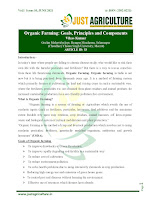Crassulacean Acid Metabolism (CAM) cycle or the dark fixation of CO2 in succulents
CAM
is a cyclic reaction occurring
in the dark phase of photosynthesis in the plants
of Crassulaceae. It is a CO2 fixation process wherein, the
first product is malic acid. It is the third
alternate pathway of Calvin cycle, occurring in mesophyll cells. The plants
exhibiting CAM cycle are called CAM plants.
Most of the CAM plants are succulents e.g., Bryophyllum,
Kalanchoe, Crassula, Sedium, Kleinia etc. It is also seen in certain plants of Cactus
e.g. Opuntia, Orchid and Pine apple families.
CAM
plants are usually
succulents and they grow under extremely xeric conditions. In these plants, the leaves are
succulent or fleshy. The mesophyll cells have larger number of chloroplasts and the vascular bundles are
not surrounded by well defined bundle sheath cells. In these plants, the stomata remain open during night and closed
during day time. The CAM plants are adapted to photosynthesis and survival under adverse xeric
conditions. CAM plants are not as efficient as C4 plants
in photosynthesis. But they are better suited to conditions of extreme desiccation.
CAM involves
two steps:
1. Acidification
2. Deacidification
Acidification
In darkness, the stored carbohydrates are converted into phophoenol pyruvic acid by the process of Glycolysis. The stomata in CAM plants are open in dark and they allow free diffusion of CO2 from the atmosphere into the leaf. Now, the phosphoenolpyruvic acid carboxylated by the enzyme phosphoenol pyruvic acid carboxylase and is converted in to oxalaoacetic acid.
The oxaloacetic acid is then reduced to malic acid in the presence of the enzyme
malic dehydrogenase. The reaction requires NADPH2 produced in
Glycolysis.
The malic acid produced in dark is stored in the vacuole.
The malic acid increases the acidity of the
tissues.
Deacidification
During day time, when the stomata are
closed, the malic acid is decarboxylated to produce
pyruvic acid and evolve carbon dioxide in the presence of the malic enzyme.
When the malic acid is removed, the
acidity decreases the cells. This is called deacidification. One molecule
of NADP+ is
reduced in this reaction.
The pyruvic acid may be oxidized to CO2 by the
pathway of Kreb’s cycle or it may be reconverted to phosphoenol pyruvic
acid and synthesize sugar by C3 cycle. The CO2 released by deacidification of malic
acid is accepted by ribulose diphosphate and is fixed to carbohydrate by C3
cycle.
CAM is a most significant pathway in succulent plants. The stomata are closed during day time to avoid transpiration loss of water. As the stomata are closed, CO2 cannot enter into the leaves from the atmosphere. However, they can carry out photosynthesis during the day time with the help of CO2 released from organic acids. During night time, organic acids are synthesized in plenty with the help of CO2 released in respiration and the CO2 entering from the atmosphere through the open stomata. Thus, the CO2 in dark acts as survival value to these plants.
Thanks
Vikas Kashyap :)














0 Comments